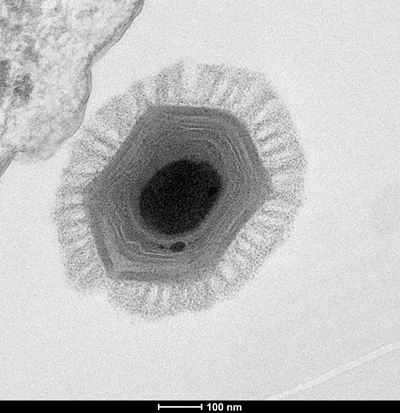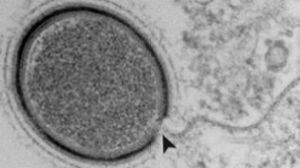The small, the big, and the giant
In a previous post, I’ve talked about the hyper-economical viruses, whose whole genome consists of as many nucleotide bases, as a single moderately big gene in higher organisms. Today, I’d like you to think about the incredible diversity nature holds, by introducing you to the complete opposite of the minimalistic PCV1 virus – the lavishly giant Megaviruses.
The secrets in the code
Until recently, scientists thought that there’s only one exceptionally large virus – Megavirus chilensis. In fact, it was considered so special, it was given its own genus – the Megavirus genus. It is so big, that it can be observed even with a light microscope – some cellular organisms are on the verge of being too small to be observed with one! Naturally, it’s not that big for no reason – it holds one of the most complex viral genomes that we know of. The computational predictions quote a possible number of about 1120 proteins being encoded in it! While this is still a relatively small number as compared to complex multi cellular organisms, it is not that far from the 4377 genes that the bacterium E. coli has.

Just when we thought we had only one
As it often happens, we were wrong about thinking that such a giant virus can evolve only once in the history of life. Recently, Prof. Abergel and her team published a research, describing yet another giant virus they discovered in the Siberian permafrost. They named it Mollivirus sibericum and it’s thought to be at least 30,000 years old. While this is not the first time we find viruses in ancient ice, it is definitely interesting new type. With every new organism discovered preserved in the ice, we learn more about the evolution of life on Earth – they represent timeless snippets of information on how life used to look like at a specific point of time as they can be dated, much like fossils.

Alive and kicking
It has been an endless discussion among biologists whether or not viruses are living organisms. As they cannot reproduce on their own, but need to infect a cell and effectively hijack their molecular machinery to replicate their viral genome and synthesize the viral genes, viruses do not fulfill a key requirement to be deemed “alive”. Despite this, lets – for the sake of the story, accept that they are indeed living things. Why? Because as it turns out – this 30,000 years old “mammoth” of a virus is still infectious! Now don’t freak out – this is not the plot for a sci-fi horror, as it’s specific to a single-cell sized host – an ancient amoeba, and definitely not to humans. Phew!
What do we do with these big guys?
Abergel is convinced that eventually we will find age-old viruses that are indeed able to infect humans, so care and precaution must be taken. Nonetheless, the more probable outcome of this, compared to humanity being wiped out by a revived epidemic, will be that we’ll gain precious knowledge about life. By studying their genetics and modes of infection, and comparing it to their modern descendants, we might even close in on the answers to the questions “How life on Earth evolved” and “How life originated“. So the dig for frozen jewels of life is definitely worth it!

